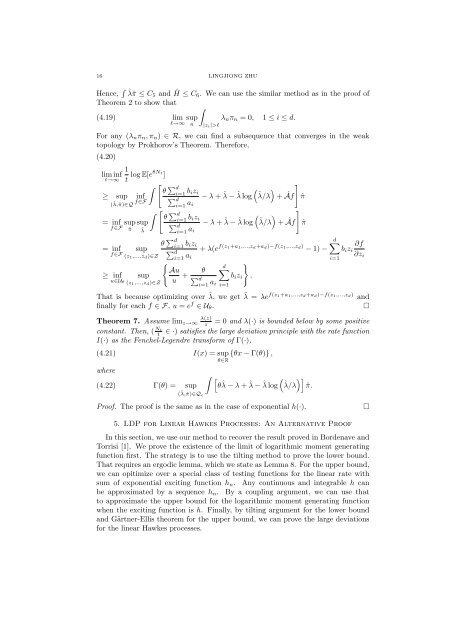LARGE DEVIATIONS FOR MARKOVIAN NONLINEAR HAWKES ...
LARGE DEVIATIONS FOR MARKOVIAN NONLINEAR HAWKES ...
LARGE DEVIATIONS FOR MARKOVIAN NONLINEAR HAWKES ...
Create successful ePaper yourself
Turn your PDF publications into a flip-book with our unique Google optimized e-Paper software.
16 LINGJIONG ZHU<br />
Hence, λˆπ ˆ ≤ C5 and ˆ H ≤ C6. We can use the similar method as in the proof of<br />
Theorem 2 to show that<br />
<br />
(4.19) lim sup<br />
ℓ→∞ n<br />
λnπn = 0,<br />
|zi|>ℓ<br />
1 ≤ i ≤ d.<br />
For any (λnπn, πn) ∈ R, we can find a subsequence that converges in the weak<br />
topology by Prokhorov’s Theorem. Therefore,<br />
(4.20)<br />
1<br />
lim inf<br />
t→∞ t log E[eθNt ]<br />
≥ sup<br />
( ˆ <br />
inf<br />
f∈F<br />
λ,ˆπ)∈Q<br />
<br />
θ d i=1 bizi<br />
d i=1 ai<br />
− λ + ˆ λ − ˆ <br />
λ log ˆλ/λ + Âf<br />
<br />
ˆπ<br />
= inf<br />
f∈F sup<br />
<br />
sup<br />
ˆπ ˆλ<br />
<br />
θ d i=1 bizi<br />
d i=1 ai<br />
− λ + ˆ λ − ˆ <br />
λ log ˆλ/λ + Âf<br />
<br />
ˆπ<br />
= inf<br />
sup<br />
f∈F (z1,...,zd)∈Z<br />
≥ inf<br />
sup<br />
u∈Uθ (z1,...,zd)∈Z<br />
θ d<br />
i=1 bizi<br />
d<br />
i=1 ai<br />
<br />
Au<br />
u +<br />
+ λ(e f(z1+a1,...,zd+ad)−f(z1,...,zd) − 1) −<br />
θ<br />
d<br />
i=1 ai<br />
d<br />
i=1<br />
bizi<br />
That is because optimizing over ˆ λ, we get ˆ λ = λe f(z1+a1,...,zd+ad)−f(z1,...,zd) and<br />
finally for each f ∈ F, u = e f ∈ Uθ. <br />
Theorem 7. Assume limz→∞ λ(z)<br />
z = 0 and λ(·) is bounded below by some positive<br />
constant. Then, ( Nt<br />
t ∈ ·) satisfies the large deviation principle with the rate function<br />
I(·) as the Fenchel-Legendre transform of Γ(·),<br />
(4.21) I(x) = sup {θx − Γ(θ)} ,<br />
θ∈R<br />
where<br />
(4.22) Γ(θ) = sup<br />
( ˆ λ,ˆπ)∈Qe<br />
<br />
.<br />
<br />
θˆ λ − λ + ˆ λ − ˆ <br />
λ log ˆλ/λ ˆπ.<br />
Proof. The proof is the same as in the case of exponential h(·). <br />
5. LDP for Linear Hawkes Processes: An Alternative Proof<br />
In this section, we use our method to recover the result proved in Bordenave and<br />
Torrisi [1]. We prove the existence of the limit of logarithmic moment generating<br />
function first. The strategy is to use the tilting method to prove the lower bound.<br />
That requires an ergodic lemma, which we state as Lemma 8. For the upper bound,<br />
we can opitimize over a special class of testing functions for the linear rate with<br />
sum of exponential exciting function hn. Any continuous and integrable h can<br />
be approximated by a sequence hn. By a coupling argument, we can use that<br />
to approximate the upper bound for the logarithmic moment generating function<br />
when the exciting function is h. Finally, by tilting argument for the lower bound<br />
and Gärtner-Ellis theorem for the upper bound, we can prove the large deviations<br />
for the linear Hawkes processes.<br />
d<br />
i=1<br />
bizi<br />
∂f<br />
∂zi
















